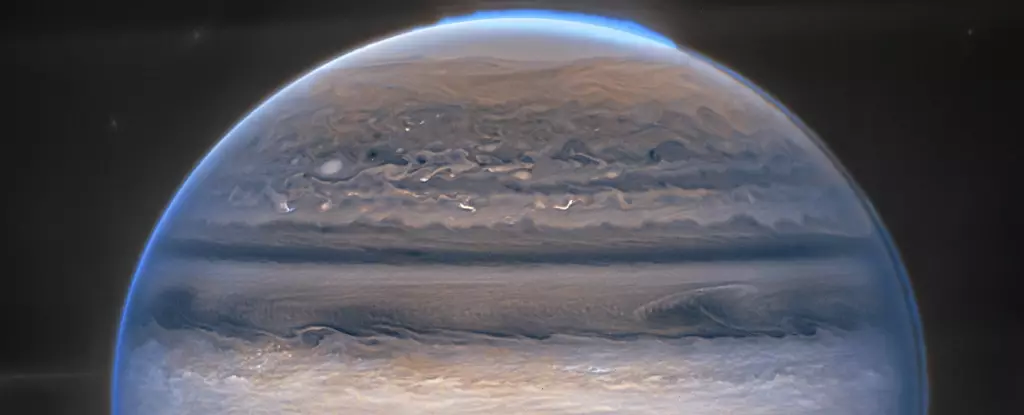Jupiter, the colossal gas giant, presents us with a bewildering astrophysical enigma: it has no solid surface. Unlike Earth, where we can tread on soil, grass, or water, Jupiter’s composition is a swirling mass of gases, primarily hydrogen and helium. This absence of a solid ground challenges our understanding of planetary structures and raises critical questions about how such a massive entity can maintain its integrity and appearance. As we look deeper into this gas giant, we begin to comprehend how its unique nature shapes not only its environment but also our solar system as a whole.
Positioned as the fifth planet from the Sun and flanked by Mars and Saturn, Jupiter is an astronomical giant with enough volume to house over 1,000 Earths. Its sheer size makes it the largest planet within our solar system, dwarfing the terrestrial bodies that are comparatively smaller and solid. The four inner planets—Mercury, Venus, Earth, and Mars—are characterized by their rocky, solid compositions, while Jupiter stands in stark contrast as a massive ball of gas. The intense winds raging across its atmosphere, reaching speeds of 400 miles per hour, resemble a colossal hurricane, far exceeding any weather phenomena we experience on Earth.
Descending through Jupiter’s atmosphere offers an incomprehensible journey into realms of pressure and temperature that are difficult to visualize. Unlike Earth, where the atmospheric pressure increases progressively until we reach the surface, Jupiter’s gaseous environment subjects explorers—be they human or robotic—to extreme conditions. As one travels deeper into Jupiter’s thick atmosphere, the gravitational force compresses the gas beyond recognition. By the time you reach depths of about 1,000 miles, the gaseous hydrogen transitions into a dense liquid form, creating vast depths of liquid hydrogen. This “ocean” is notably devoid of water, exemplifying the unique characteristics that define Jupiter.
Further into the planet’s interior, roughly 20,000 miles down, the liquid hydrogen morphs into a strange phase known as metallic hydrogen. In this state, electrons are free to move, creating an exotic and uncharted material that scientists have only begun to replicate under laboratory conditions. This gradual transformation from gaseous to liquid and ultimately to a metallic state adds to the complexity of Jupiter, emphasizing its lack of clear boundaries and traditional characteristics associated with solid bodies.
As one approaches Jupiter’s core, we encounter another layer of mystique. The core, often misrepresented as a solid mass, is better understood as an exceedingly hot, dense region—characterized by extreme pressure measuring nearly 100 million times that found on Earth’s surface. The core is estimated to be a mix of metallic and liquid properties, challenging our assumptions about planetary structure. Navigating through the extreme heat of about 35,000 degrees Fahrenheit presents additional challenges. These conditions are hostile to any exploration efforts, complicating attempts to glimpse the innermost workings of this gas giant.
Although an inhospitable place for life as we know it, Jupiter plays a pivotal role in maintaining the stability of our solar system. Its immense gravitational pull acts as a protective shield for the inner planets, redirecting potentially destructive asteroids and comets away from Earth. This protective function may have been crucial in preventing catastrophic collisions throughout our planet’s history, shaping our evolutionary trajectory. Some scientists posit that without Jupiter, life on Earth could have been drastically different or even non-existent.
Despite the harsh conditions on Jupiter itself, its moons, particularly Europa, harbor tantalizing possibilities for life. Europa is encased in a thick icy crust that is believed to cover a vast subsurface ocean, raising intriguing questions about the potential for extraterrestrial life. NASA’s upcoming Europa Clipper mission, set to launch in October 2024, aims to conduct extensive flybys of this intriguing moon, paving the way for discoveries that could reshape our understanding of life’s adaptability in the cosmos. With arrival slated for April 2030, scientists anticipate groundbreaking revelations as the probe investigates the depths of Europa’s ocean.
Jupiter stands as a testament to the astonishing diversity of our solar system. Its gas-dominated environment, mysterious core, and protective gravitational influence highlight the planet’s duality as both a forbidding giant and a crucial player in the cosmic balance. The pursuit of knowledge about this gas giant continues, illuminating not just the planet itself but the broader tapestry of existence in our universe. As we venture further into the cosmos, Jupiter remains a focal point for inquiry, revealing the untold wonders that lie beyond our terrestrial experience.


Leave a Reply